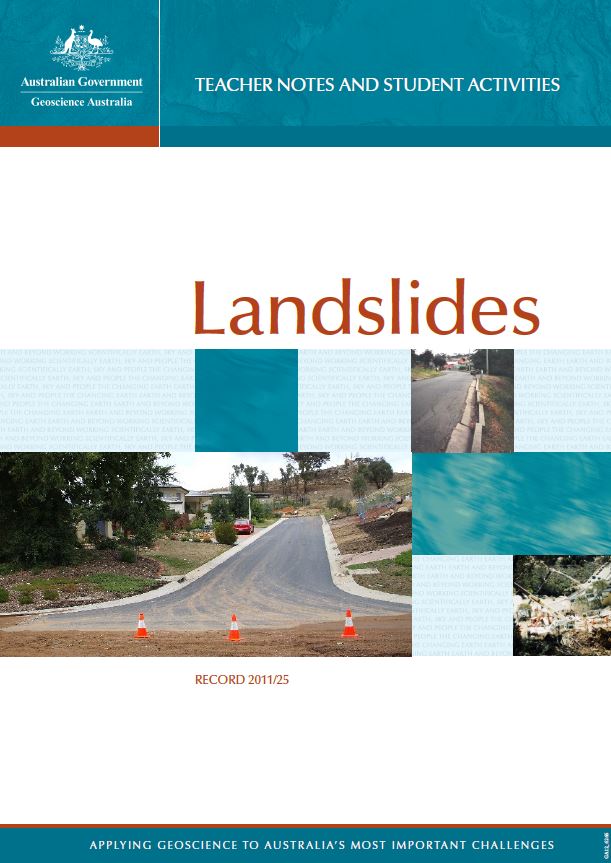landslides
Type of resources
Keywords
Publication year
Scale
Topics
-
The report is the fourth in a series of multi-hazard case studies by the Geoscience Australia Cities Project. It is a summary report which considers tropical cyclone, including severe wind and storm tide at Gladstone. It also provides an overview of the risks posed by severe thunderstorms, floods, landslides, heatwaves, bushfires and earthquakes. Produced in conjunction with the Bureau of Meteorology and in cooperation with Queensland Department of Emergency Services, Gladstone City Council and Calliope Shire Council.
-
An analysis defining potential landslide hazard over a 650 km2 region of southeast Queensland, Australia is presented. Attributes of geology, slope, aspect, morphology, curvature and vegetation were de-termined for the study area at a 5 m pixel resolution within a GIS environment. A decision tree analysis was employed to gather attribute values from landslides mapped following the 25-28th January 1974 rainfall event and to use this data as training for the prediction of further areas of potential instability. Application of a deci-sion tree analysis creates rulesets of the most ?informative? attributes that define areas of landslide potential as well as attributes that define areas of little landslide potential. The rulesets were then imported back into a GIS environment where they were located spatially. Field checking indicates that the predictions for further areas of potential landslide activity within this region are intuitively sound. It is envisaged that this research will prove beneficial to managers and land use planners involved in regional assessments.
-
The important role of information management in improving baseline data for natural hazards has been demonstrated through a collaborative pilot project between Geoscience Australia, Mineral Resources Tasmania and the University of Wollongong. The result is a 'virtual' landslide database that makes full use of diverse data across three levels of government and has enabled landslide data to be collated and accessed from a single source. Such a system establishes the foundation for a very powerful and coordinated information resource in Australia and provides a suitable basis for greater investment in data collection. This paper highlights the capacity to extend the methodology across all hazards and describes one solution in facilitating a sound knowledge base on natural disasters and disaster risk reduction.
-
In the following discussion the term 'landslides' is used in a very broad sense to include rock falls, topples, flows of solid material and slow movements of a few tens of centimeters per year.
-
Natural hazards have an impact on every Australian State and Territory. These hazards include bushfires, cyclones, earthquakes, floods, landslides, severe weather, tsunami and volcanoes. These phenomena threaten lives and damage private and public assets, as well as disrupt water, power, transport and communication services. These hazards and their associated impacts also can seriously affect employment, public administration and incomes to industry, agriculture and commerce.
-
This set of 15 Australian landslide images on CD-ROM with accompanying explanatory text illustrates the causes of landslides and other earth movements. Learn how people contribute to creating and mitigating such events. Landslide images include Thredbo, NSW, Sorrento Vic., Gracetown WA and Tasmania. Suitable for secondary level Years 7-12.
-
<p><b>Taken down from public access 30/01/2020 On advice from Jane Sexton.</b> <p>Colour brochure about landslide awareness and what to do in unstable areas.
-
Landslide in Australia, for the most part, is not seen as a major threat to our urban communities. However, this general belief is far from the reality of the situation. Our history of landsliding is highlighted with devastating events such: <li>Thredbo landslide, July 1997; 18 people killed</li> <li>Gracetown cliff collapse, September 1996; 9 people killed.</li> In Australia, there have been 37 recorded fatal landslides since 1842, which have been responsible for the deaths of 83 people. It is almost certain that these statistics are incomplete and that the number of fatalities is much higher. The city of Wollongong is on Australia's east coast, approximately 80 km south of Sydney. Today, Wollongong has one of the highest population growth rates in NSW. Since 1887, 478 landslides have been recorded at Wollongong, at least two people have been killed, more than 200 buildings destroyed or damaged and there is constant disruption to infrastructure and services. It is estimated that between 1989 and 1996, the cost of landsliding to railway infrastructure alone in Wollongong was A$25 million annually. Extensive areas of the Wollongong hinterland are prone to landsliding from heavy rainfall events, as demonstrated by the August 1998 storms. During this event, 148 landslides were reported and access to the city was cut by landslides and floodwaters for up to 24 hours. It is estimated that up to A$100 million dollars damage resulted.
-

Landslides are one of Australia's most dangerous natural hazards and result from a mass movement of material down a slope or cliff face. This 50 page booklet explains the nature of landslides and gives examples of various historical landslides that have occurred in Australia. Student activities with answers included. Suitable for upper primary and high school teachers.
-
This database allows users to search for - naturally-occurring landslides - landslides with a significant human contribution or directly triggered by humans,- flood events causing significant erosion, and - flash flood events involving mud or debris - which have been recorded by Geoscience Australia and contributing scientific organisations and returns these landslide and flood events along with their associated data. - Human-triggered landslides include events such as sand collapses caused by children digging holes or tunnels, boulders displaced by climbers, rock ledges breaking off when a person stands or sits on them, and collapses caused by excavation. Landslides are often called landslips and the terms are interchangeable. Last updated June 2018
